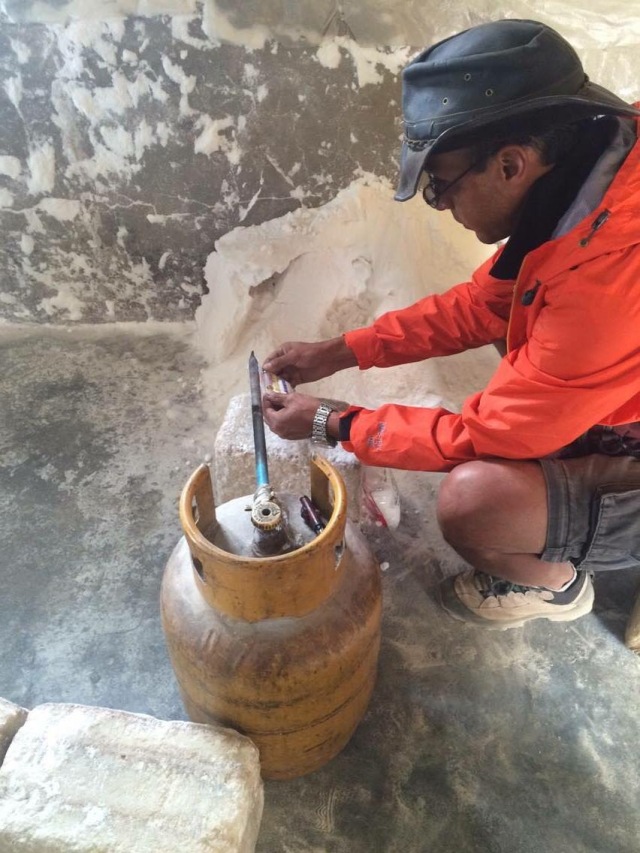
The foundation of a friendship can spark from a multitude of things. This morning the fellows in Bolivia found friendship in the community of Samiri, located near Toledo. Here we were fortunate to meet and learn from the Wilfredo Canaviri Saca family, who produces Canahua, a ‘sister crop’ to quinoa, and sheep.
It didn’t take long for us to find common ground. Wilfredo’s family’s goal is to produce the healthiest food possible for people that live in the cities near by. Our friendship was struck on the concept that producing food and feeding people has no boundaries – not race, religion, location or methods.
We were excited to find that they too have developed different innovative techniques to better their farm. Wilfredo’s parents gave him the opportunity to study at a University, and he has worked hard to provide that for his children, too. His oldest son and daughter are currently studying anthropology and graphic design, respectively. A wise mentor once said, “If you are uncertain of your purpose, follow your passion – it will lead you there.” The daughter is utilizing her skills to promote and brand their products. She had created banners, logos and helped increase the demand for both Canahua and their sheep through marketing. Thus far we have seen little communication between Bolivian farmers and their consumers, so their marketing serves as a great advantage.
 Wilfredo’s wife plays a crucial role on the farm – she was a natural educator – first informing us about their practices raising sheep. We were happy to hear that they have imported other breeds – Suffolks, Hampshires and Corriedales – to implement a cross-breeding program with the native breeds in order to improve meat quality, and better their herd. The first cross offspring have one of two fates. The top 2-3% of bucks are kept and bred to native ewes, and the rest of the males are marketed live or as a carcass product. All female cross offspring are sold to prevent inbreeding. While their management program is simple, they are keeping track of genetic lines and utilizing identification practices in the herd – something that seems to be quite rare in this country.
Wilfredo’s wife plays a crucial role on the farm – she was a natural educator – first informing us about their practices raising sheep. We were happy to hear that they have imported other breeds – Suffolks, Hampshires and Corriedales – to implement a cross-breeding program with the native breeds in order to improve meat quality, and better their herd. The first cross offspring have one of two fates. The top 2-3% of bucks are kept and bred to native ewes, and the rest of the males are marketed live or as a carcass product. All female cross offspring are sold to prevent inbreeding. While their management program is simple, they are keeping track of genetic lines and utilizing identification practices in the herd – something that seems to be quite rare in this country.
The compliment to their sheep production is that of Canahua – “the grain that makes your life longer.” The sheep eat the Canahua stubble and their manure fertilizes the soil. Canahua is unique in the fact that it can be produced in drier air and colder and higher altitude climates than even quinoa. In addition, it actually has an even higher percent of protein, as well as being a good source of calcium, phosphorus, fiber and potassium, and can treat ailments including altitude sickness, typhoid fever and indigestion while serving as an energy source. We were all able to taste canahua flour. The best comparison can be made with a protein powder – it even had a slight chocolate taste! Although they have never completely lost a crop, they do suffer from many of the same plagues that quinoa producers experience.

 We were able to spend quite a bit of time with this family, and our friendships grew. They were able to show us some sheep, their machinery, and water reservoirs. In return, we told them about were we come from and what agriculture looks like in our respective states as well as answering questions and sharing pictures! Lunch was served – homegrown lamb, and other items made with quinoa and Canahua. Their generosity continued as we received parting gifts: small clay momentos with wool and Canahua seed as well as a small bag of the Canahua flour. It was a very special moment for both parties, and as contact information was exchanged, we sincerely hope these friendships will continue.
We were able to spend quite a bit of time with this family, and our friendships grew. They were able to show us some sheep, their machinery, and water reservoirs. In return, we told them about were we come from and what agriculture looks like in our respective states as well as answering questions and sharing pictures! Lunch was served – homegrown lamb, and other items made with quinoa and Canahua. Their generosity continued as we received parting gifts: small clay momentos with wool and Canahua seed as well as a small bag of the Canahua flour. It was a very special moment for both parties, and as contact information was exchanged, we sincerely hope these friendships will continue.
After a very busy morning, we made our way back to Oruro. We all experienced Bolivian public transportation for the first time as our drivers from the past few days dropped us at the bus stop so we could make the journey to La Paz. For many of us, this was quite the experience – awestruck, fearful and enthralling could describe it all! But alas, we all made to La Paz in one piece. The city is bustling, built on the mountain, and jam packed with shops, people, and traffic. We’re looking forward to the rest of our adventure here!
Happy Trails!
Emma Christensen
South Dakota State University











































